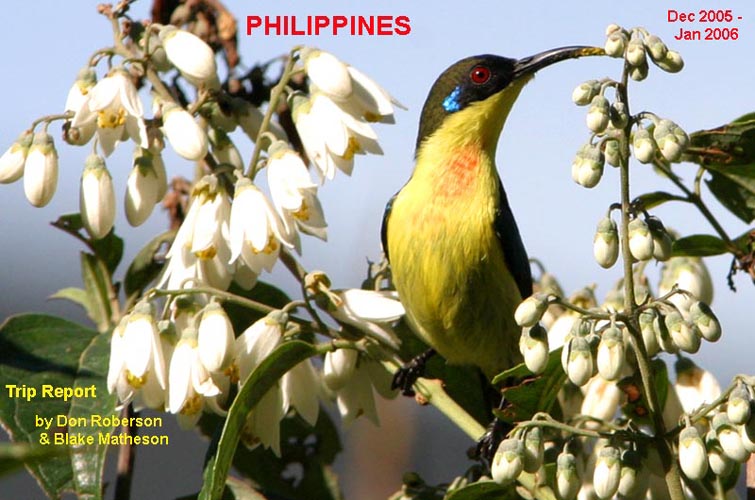

|
|
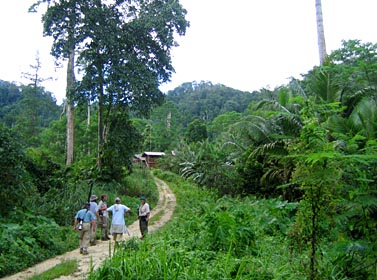 |
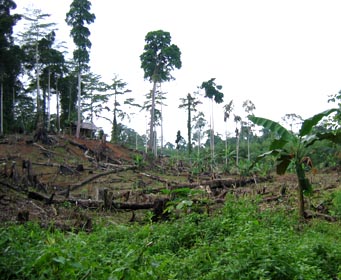 |
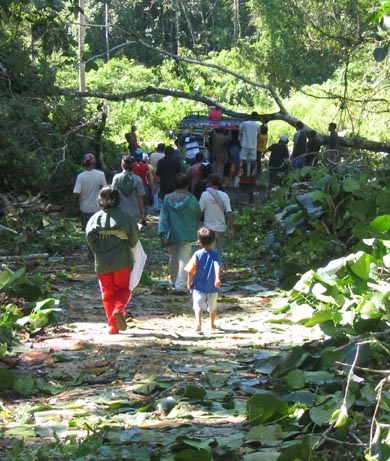 26—28
Dec (PICOP forest, Mindanao): PICOP stands for "Paper Industries
Corporation of the Philippines." It is a huge logging concession in the
eastern lowlands around Bislig, Mindanao. Legal logging was heavily underway
when I was there in 1990; today, most of the legal logging has ended. Instead,
illegal logging and slash-and-burn agriculture is overwhelming the remaining
forest. Tim says it gets worse every time he visits. We bird along the
logging roads (above left) but now there are many spots that are almost
clear-cut (above right; photos © Jon & Anne King). 26—28
Dec (PICOP forest, Mindanao): PICOP stands for "Paper Industries
Corporation of the Philippines." It is a huge logging concession in the
eastern lowlands around Bislig, Mindanao. Legal logging was heavily underway
when I was there in 1990; today, most of the legal logging has ended. Instead,
illegal logging and slash-and-burn agriculture is overwhelming the remaining
forest. Tim says it gets worse every time he visits. We bird along the
logging roads (above left) but now there are many spots that are almost
clear-cut (above right; photos © Jon & Anne King).
Several times our way was blocked by parked logging trucks, and once (right; photo © Jon & Anne King) by a tree that had just been felled. It took about a half-hour for the locals to chop through the trunk with axes so that we could continue on our way. We had with us a local guide (Zardo) who worked in the security division of PICOP. He said that while PICOP did license some local lumbering here and there, virtually all the logging we saw was illegal. The larger efforts — like the logging truck full of recently cut trees shown below (left) — were actually undertaken by the rebel "New People's Army." While this insurgent group has not targeted foreigners, they engage in a running battle with the local military and PICOP security forces. The NPA essentially rules the rural areas. Their illegal logging used to be undertaken at night, said Zardo, but now they brazenly cut timber throughout the day. Illegal immigrants have also penetrated the forest and are cutting and burning everywhere. We passed through small village after small village of squatters. PICOP tries to control this, but is losing. The forest is rapidly disappearing. This is all inconsolably sad . . . and yet there were humorous moments as well, such as this family of "seven on a bike" (below right; photos © Anne & Jon King). |
|||||||
|
|||||||
|
|
|||||||
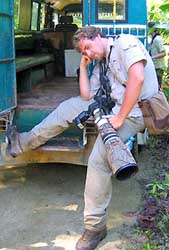 We
birded PICOP forest for three-and-half days. We were up before dawn and
almost always returned after dark. It was usually a 2 hour ride in our
jeepney, over bumpy, often muddy, roads, to reach our birding locales.
Road 1-4 is a traditional site, and we spent a lot of time there, but it
is now very chopped up. Still — it was not unusual to see a flight of Rufous
Hornbill (above; one of a flight of six overhead). We spent even more
time on Roads 4 and 4A — even farther out in the forest — because they
still retained larger patches of jungle. We
birded PICOP forest for three-and-half days. We were up before dawn and
almost always returned after dark. It was usually a 2 hour ride in our
jeepney, over bumpy, often muddy, roads, to reach our birding locales.
Road 1-4 is a traditional site, and we spent a lot of time there, but it
is now very chopped up. Still — it was not unusual to see a flight of Rufous
Hornbill (above; one of a flight of six overhead). We spent even more
time on Roads 4 and 4A — even farther out in the forest — because they
still retained larger patches of jungle.
This is tiring work. Each good bird was a significant effort. Over two hours effort to see Red-bellied Pitta. Another two hours on another day to see a male Celestial Monarch, not including the many hours 'trolling' for it with tape before that. A solid hour trying to get decent views of Short-crested Monarch. But the birds did come eventually. We also visited the Bislig marsh for a variety of waterfowl and, at dusk, Philippine Nightjar. We were now into the fourth week of the trip, and the pace is catching up with some of us. Throughout it all, Blake lugged around his big lens (right; photo © Jon & Anne King). But his effort was rewarded. Here's a short gallery of some of Blake's PICOP photos: |
|||||||
|
|||||||
PICOP added quite a number of other species as well: mixed species flocks
that including Rufous Paradise-Flycatcher; several Philippine
Trogon; an evening roost of Pompadour Green Pigeon; and good
views of single Yellow-breasted Fruit-Dove and, early one morning,
a calling Pink-bellied Imperial Pigeon. We also stayed into the
night to see such owls as Mindanao Hawk-Owl, the recently split
Chocolate
Hawk-Owl, and Philippine Scops-Owl.
|
|||||||
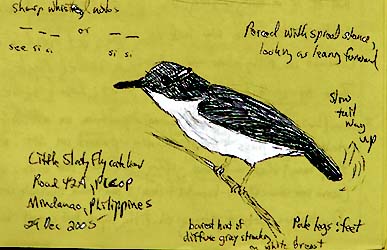 29
Dec: This was our travel day to get back to Manila, but we did have
the morning (if needed) to search for missing species. There was one: Little
Slaty Flycatcher. We had tried a 'stake-out' spot well out Road 4A previously,
and had no response to the tape. But that had been at mid-day. So we got
up a 3 am and were on the road by 3:30 to give it one last try. Enroute
we tried for owls on Road 4, and actually heard a Giant Scops-Owl
not too distant, but again couldn't see it. 29
Dec: This was our travel day to get back to Manila, but we did have
the morning (if needed) to search for missing species. There was one: Little
Slaty Flycatcher. We had tried a 'stake-out' spot well out Road 4A previously,
and had no response to the tape. But that had been at mid-day. So we got
up a 3 am and were on the road by 3:30 to give it one last try. Enroute
we tried for owls on Road 4, and actually heard a Giant Scops-Owl
not too distant, but again couldn't see it.
We finally reach the flycatcher spot again. Besides the long drive, it required scrambling down a steep gully to a quiet little dale that looks like a Hobbit's garden. We tried Tim's tape again — and this time a very engaging male responded! He was still shy and usually hard-to-see but he circled our group several times, always in thickets within a meter of the ground. We eventually had stunning views of this great little bird, an impressive enough experience to make it into several of our personal 'top ten' birds-of-the-trip lists. It impressed me enough to do a little field sketch (right or above; color added in PhotoShop afterwards). Then it was the long 5 hour drive back to Davao for the 6 pm flight to Manila. Back in our Manila hotel by 9 pm. |
|||||||
30 Dec (to Banaue, Luzon): Despite the late night arrival,
we are up early for a 5 am departure — it is critical to beat Manila traffic
in getting out of town. This will be a long day's drive to Banaue in northern
Luzon. Traffic through the interior is dense anyway, and we won't arrive
at our hotel until after dark. To break up the drive, we elect to stop
'briefly' at Candaba Marsh. When I was here in 1990 there still were reed
beds with wintering Streaked Reed-Warblers, but today Candaba Marsh
is all wet rice paddies and muddy roads (below; photo © Jon
& Anne King). Yet among the ag fields are ponds and wet mud, and lots
and lots of shorebirds and waterfowl.
 |
|||||||

 |
|||||||
Most of the important birds are in the mossy cloud forest up near the pass. Some are exceptionally secretive in the thick undergrowth, like Luzon Bush-Warbler (right; Don got this shot when the warbler sun-bathed in a tiny beam of sunshine). Some species were so secretive (e.g., Long-tailed Ground-Warbler, Benguet's Bush-Warbler) that we never got views despite being close of vocalizing birds responding half-heartedly to the page (the same can be said for several Luzon Scops-Owls that night). But we did well with more cooperative species, such as Metallic-winged Sunbird (photo top of page as the title shot), Mountain Tailorbird, Chestnut-faced Babbler, and Green-backed Whistler. We had three highlight species here: Whitehead's Swiftlet [3 flew up-canyon shortly after dawn and were encountered at the pass several times thereafter; see the annotated list for more details]; an impressive Grand Rhabdornis that Volker first picked up in flight but that landed closer and closer for stunning views; photo © Blake Matheson, below left]; and Mountain Shrike, a lone bird that perched upslope in the mossy mid-canopy [photo © D. Roberson, below right]. |
|||||||
|
|||||||
|
|||||||
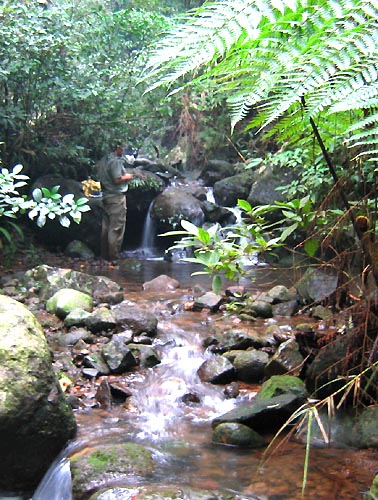 1—5
Jan (the Hamut hike, Luzon): There still is extensive forest
in the Sierra Madre of northeastern Luzon. To reach it, an expedition
must be mounted. The hike to Hamut — a pig-hunters camping site
at 900m (~3000' elev.) on the slopes of Mt. Dos Carneros — was pioneered
by Danish ornithologists in the 1990s, and Tim has brought parties here
several times. since. The good forest here was selectively logged several
decades ago, and all the northern Luzon mid-elevation specialty birds are
still here. One starts from the city of Tugergarao. Then it is an hour's
jeepney ride straight east, on muddy roads that is was a wonder the jeepney
could manage (it had been raining for a week straight before we arrived),
to the tiny village of Baliwag. 1—5
Jan (the Hamut hike, Luzon): There still is extensive forest
in the Sierra Madre of northeastern Luzon. To reach it, an expedition
must be mounted. The hike to Hamut — a pig-hunters camping site
at 900m (~3000' elev.) on the slopes of Mt. Dos Carneros — was pioneered
by Danish ornithologists in the 1990s, and Tim has brought parties here
several times. since. The good forest here was selectively logged several
decades ago, and all the northern Luzon mid-elevation specialty birds are
still here. One starts from the city of Tugergarao. Then it is an hour's
jeepney ride straight east, on muddy roads that is was a wonder the jeepney
could manage (it had been raining for a week straight before we arrived),
to the tiny village of Baliwag.
Here one collects porters and guides. There are six of us: we need 12 porters and 2 guides to stay in the forest for 4 nights. Baliwag is at only 80m (260') elev., so it will be a long, hard hike to the ridge at 1000m (3300'; photo above right) to drop into the watershed to our upper camp. That is a two-day hike for us, broken at "camp 1" in a deserted village at the edge of the forest. The first day's hike is primarily upwards throughout denuded grasslands (photo above left shows that habitat and some of our porters at rest; © Jon & Anne King). That first day is a 4.5 hour hike for us (much faster for the porters, though). As it took so long to pack all our gear and food into waterproof bags that porters could carry, we got a late start (2 pm) and the last hour of the hike is in the dark. What slows us down considerably is the exceptionally muddy trail — essentially a buffalo wallow much of the way — with thick, sticky muddy that is calf-deep unless one carefully skirts the edges. It is frustrating and maddening. The second day's hike is on a better trail, inside the forest much of the time, but the altitude gain is substantial. We leave Camp 1 at 6:15 am and don't reach Camp 2 until 4 pm. Camp 2 — Hamut itself — is set in a lovely forested canyon next to a running brook (right). It is safe to drink from the stream (or at least Tim does) when others aren't using it to wash dishes or bathe. The porters and guides efficiently set up a 'dining room & kitchen" (below left), including fashioning a table and benches out of limbs and vines, and they will use the area around the fire to sleep together at night (some sit around the fire in photo, below right; all these shots © Jon & Anne King). They also set up our individual tents, complete with rain flies, which prove to be very comfortable. |
|||||||
|
|||||||
 For
most of us, the most important bird here is Whiskered Pitta. We
do hear a few calling each day we are inside the forest (days 2, 3, 4 of
the hike) but each time the bird is too distant, often well downslope in
exceedingly thick and impenetrable undergrowth. Efforts at taping
sometimes bring half-hearted responses, but no movement toward us. By Day
4 we are beginning to think we are too early in the season for any responsive
pitta (most prior trips have been here in March-May). We are just about
getting below their elevational zone on the hike down on Day 4 when we
hear our final pitta. But this one responds! It is on a steep hillside
with abundant ferns and dense thickets, and it takes an hour of work, but
eventually almost all of us get views (AK unfortunately missed it). More
details are in the annotated list; I did a sketch in my field notes of
my view of the pitta's head — which it bobbed in rhythm to its quavering,
dove-like series of calls — through thick branches (right; the color was
added in PhotoShop much later). Actual photos of Whiskered Pitta in the
wild were published by Morris (1997). For
most of us, the most important bird here is Whiskered Pitta. We
do hear a few calling each day we are inside the forest (days 2, 3, 4 of
the hike) but each time the bird is too distant, often well downslope in
exceedingly thick and impenetrable undergrowth. Efforts at taping
sometimes bring half-hearted responses, but no movement toward us. By Day
4 we are beginning to think we are too early in the season for any responsive
pitta (most prior trips have been here in March-May). We are just about
getting below their elevational zone on the hike down on Day 4 when we
hear our final pitta. But this one responds! It is on a steep hillside
with abundant ferns and dense thickets, and it takes an hour of work, but
eventually almost all of us get views (AK unfortunately missed it). More
details are in the annotated list; I did a sketch in my field notes of
my view of the pitta's head — which it bobbed in rhythm to its quavering,
dove-like series of calls — through thick branches (right; the color was
added in PhotoShop much later). Actual photos of Whiskered Pitta in the
wild were published by Morris (1997). |
|||||||
Don writes:
It took ony half the time to hike down from
Camp 1 as it did to hike up to it, and we were finally back to roads and
vehicles. A mid-day flight from Tugergarao takes us back to Manila; the
next day most of us fly home.
|
|||||||
|
|||||||
|
|||||||
| PHOTOS: All photos on this page are © 2006 Don Roberson,
except those © Blake Matheson, © Anne & Jon King, or ©
Volker Schmidt, and so indicated; all rights reserved. Many other shots
from this trip are scattered about this web site.
Literature cited: Morris, P. 1997. Photospot: Whiskered Pitta. Oriental Bird Club Bulletin 25: 56-57.TOP TO LIST OF BIRD FAMILIES OF THE WORLD |